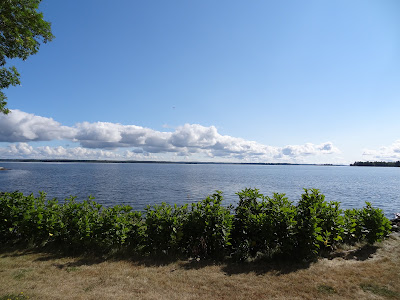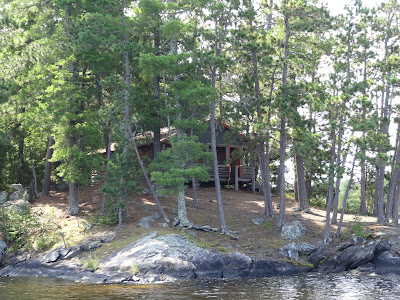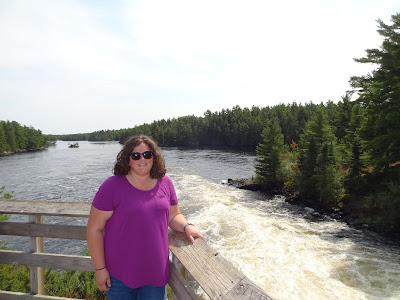Nearby town: International Falls, MN
"I could carry, paddle, walk, and sing with any man I ever saw. I have been twenty-four years a canoe man, and forty-one years in service; no portage was ever too long for me, fifty songs could I sing. I have saved the lives of ten voyageurs, have had twelve wives and six running dogs. I spent all my money in pleasure. Were I young again, I would spend my life the same way over. There is no life so happy as a voyageur's life!"
-an anonymous retired voyageur, quoted in the book "Lake Superior" by James H. Baker, Secretary of State of Minnesota 1860-1862
In the far reaches of Minnesota, along the border with Canada, Voyageurs National Park protects the pristine wilderness of the Kabetogama Peninsula and its surrounding lakes; Rainy Lake, Kabetogama Lake, and Namakan Lake.
From the 1680s all the way to about the 1870s or so, this area was a prime hub of the fur trade industry. Voyageurs (French for "travelers") were French Canadians - mostly from the Montreal area - who would be hired by wealthy merchants to travel by large canoes up the St. Lawrence River all the way to the western edge of Lake Superior. There, at Grand Portage, they would take smaller canoes and venture into the wilderness to trap and trade with Native Americans for pelts and fur of a variety of animals: marten, otter, lynx, mink, and especially beaver. They would then transport the furs all the way back to Montreal for export across the ocean to Europe. They would repeat this process throughout the year until the wintry weather made the journey impossible. As hats made from beaver fur became incredibly popular in the cities on the East Coast and Europe, the business exploded and at its height in the 1810s, there were over 3,000 voyageurs.
The voyageurs were highly valued employees of the prominent fur companies; including the Hudson's Bay Company, the North West Company, and the American Fur Company. Voyageurs would arise daily at around 2 in the morning and begin the long day of paddling. Voyageurs were expected to work 14 hours a day and paddle at a rate of 55 strokes per minute. They would take a short break once an hour to smoke pipe. Distance was measured in "pipes" (distance traversed between breaks). Obviously there was little time to hunt for food, so a voyageurs diet mainly consisted of what they could store in the canoe: packaged meals such as salt pork, rubaboo (a stew made from dried peas or beans), sea biscuits and pemmican (dried meat pounded into small pieces mixed with fat).
When it came time to carry the canoes and cargo over land (what is known as "portaging"), voyageurs were expected to carry two bales of fur, each weighing 90 lbs. for a total of 180 lbs. Some carried more, to reduce the amount of trips back and forth to portage all the cargo. There is a report of a freed slave that became a voyageur named La Bonga, who was 6 ft 5 in. tall and once carried 7 bales (630 lbs.) for a distance of one-half mile.
This was dangerous work; many voyageurs never learned to swim and drowning was common, as was broken limbs, compressed spines and hernias (due to all the heavy lifting).
Music was an everyday part of life for the voyageurs. The men would sing as they paddled, to help pass the time and improve and boost morale. Furthermore, the rhythm of the songs helped synchronize their paddling. Some of the most popular songs were "Alouette" and "A la claire fontaine." Canadian school children to this day learn voyageurs songs as a part of studying French Canadian culture. The exploits and adventures of the voyageurs are legendary and a large part of Canadian social culture and history. Much like the fabled pioneers in US history.
If there is one thing to do at Voyageurs National Park, I would recommend participating in a North Canoe program. The rangers (in traditional Voyageur garb) will teach you all about their history and then take a group out onto the lake in a replica canoe. The rangers stay in character the whole time, and you'll sing songs, and all that stuff. It's very fun and enjoyable. It's free, but you do need to sign up for it, so call ahead and reserve a spot. It's available at either the Rainy Lake Visitor Center or the Lake Kabetogama Visitor Center. We did ours at Lake Kabetogama.
 |
| Lake Kabetogama |
 |
| The Voyageurs |
There are three visitor centers in the park (from east to west): (1) Ash River (2) Lake Kabetogama (think of the Roman "toga" when you pronounce it: Caw-be-toe-gama) and (3) Rainy Lake. These visitors centers lie on the outskirts of the park. Most of the park lies on the Kabetogama peninsula (which can only be accessed by boat) and 40% of the park is water. You can't really explore the park in your car, so to truly experience the park you need to get out on the lakes and rivers with your own boating equipment, or rent some, or go on guided tours.
In the Ash River section of the park, take the Blind Ash Bay Trail for outstanding views of Lake Kabetogama.
Make sure to stop at the Ash River Visitor Center for scenic views and a great picnic stop. The narrows here connect Lake Kabetogama with Namakan Lake.
We also stopped at the Rainy Lake Visitor Center to soak in the views.
 |
| saw some turtles on a log basking in the sun |
Kettle Falls is an area of rapids located in the waterway connecting Lake Kabetogama with Rainy Lake. The falls required voyageurs to portage at this spot. In 1910 a dam was built here. And in 1913, the Kettle Falls Hotel was built here, right on the edge of the Kabetogama Peninsula. This historic hotel still operates today. It is the only lodging inside park boundaries, and is only accessible by boat. The boat from the visitor center is a small pontoon boat (I understand the boat from Rainy Lake is much bigger). Reserve ahead of time to make sure you get a spot on the boat. The small group made for an excellent guided tour and lots of opportunity to view wildlife. The boat ride takes a couple of hours but the rangers make it interesting. Don't worry about motion sickness, these are calm waters. Once you get to Kettle Falls you'll have an hour or so to explore on your own, eat at the hotel's restaurant, see the dam, etc.
 |
| bald eagle |
 |
| Kettle Falls Hotel |
 |
| hotel patio |
 |
| the floor of the billiard room was very warped |
 |
| the rapids of Kettle Falls |
We loved our visit to Voyageurs National Park. If you find yourself in Minnesota, head north to experience this natural wonder and learn of its unique history. If you visit, make sure to take a guided tour or bring a boat so you can experience this part from the water as intended. More info here: https://www.nps.gov/voya/index.htm




















































Awesome. Love your pictures.
ReplyDeleteThank you!
Delete